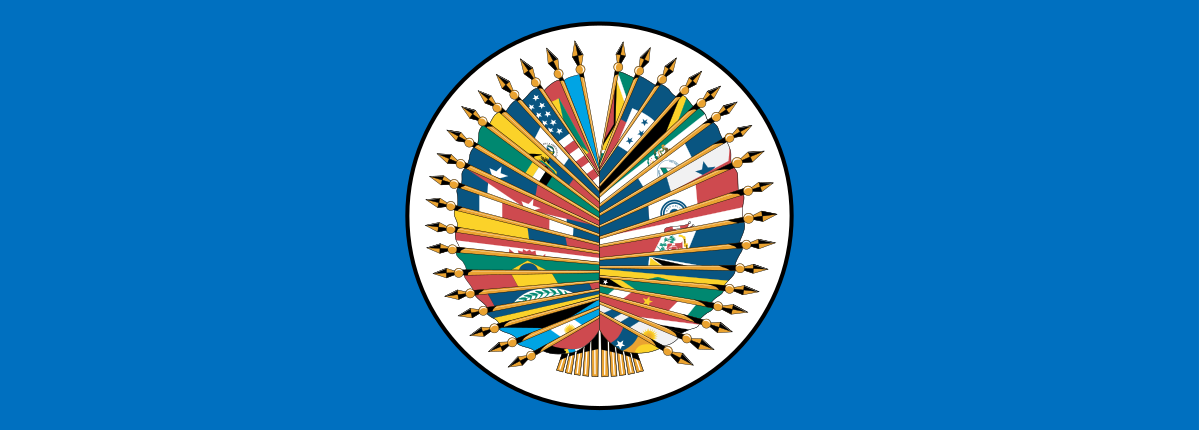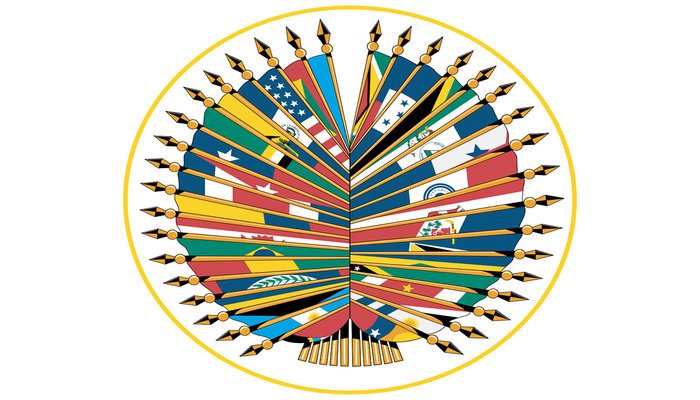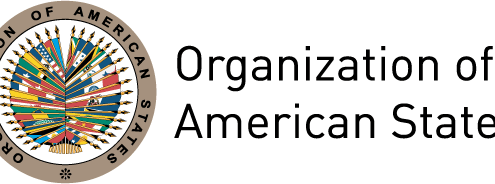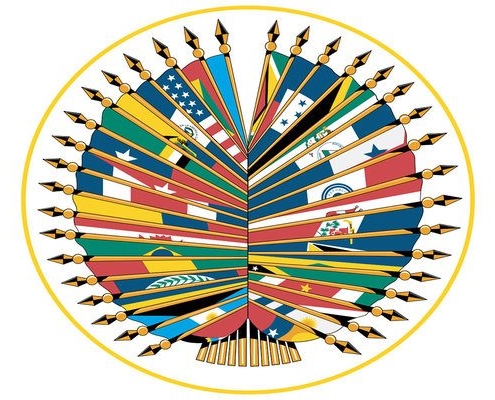Organization of American States
| Organization of American States | |
| Flag
|
|
| Motto: “Democracy for peace, security, and development” |
|
| Headquarters | Washington, D.C., U.S. 38°53′34″N 77°02′25″WCoordinates: 38°53′34″N 77°02′25″W |
| Largest city | São Paulo |
| Official languages | Spanish English Portuguese French |
| Member states | 35 states |
| Leaders | |
| • Secretary General | Luis Almagro |
| • Assistant Secretary General | Nestor Mendez |
| Establishment | |
| • Charter | 30 April 1948 |
| Area | |
| • Total | 4,027,568 km2 (1,555,053 sq mi) |
| Population | |
| • 2008 estimate | 980,457,921 |
| • Density | 24/km2 (62.2/sq mi) |
| Time zone | UTC-10 to +0 |
| Website oas.org |
|
The Organization of American States (Spanish: Organización de los Estados Americanos, Portuguese: Organização dos Estados Americanos, French: Organisation des États américains), or the OAS or OEA, is a continental organization that was founded on 30 April 1948, for the purposes of solidarity and cooperation among its member states within the Western Hemisphere. During the Cold War, the United States hoped the OAS would be a bulwark against the spread of communism.[1] Since the 1990s, the organization has focused on election monitoring. Headquartered in the United States‘ capital Washington, D.C., the OAS’s members are the 35 independent states of the Americas.
As of 26 May 2015, the Secretary General of OAS is Luis Almagro

The Pan American Union shortly after its construction in 1910
The notion of an international union in the New World was first put forward during the liberation of the Americas by José de San Martín and Simón Bolívar[3] who, at the 1826 Congress of Panama (still being part of Colombia), proposed creating a league of American republics, with a common military, a mutual defense pact, and a supranational parliamentary assembly. This meeting was attended by representatives of Gran Colombia (comprising the modern-day countries of Colombia, Ecuador, Panama and Venezuela), Argentina, Peru, Bolivia, The United Provinces of Central America, and Mexico but the grandly titled “Treaty of Union, League, and Perpetual Confederation” was ultimately ratified only by Gran Colombia. Bolívar’s dream soon floundered with civil war in Gran Colombia, the disintegration of Central America, and the emergence of national rather than New World outlooks in the newly independent American republics. Bolívar’s dream of American unity was meant to unify Hispanic American nations against external powers.
The pursuit of regional solidarity and cooperation again came to the forefront in 1889–1890, at the First International Conference of American States. Gathered together in Washington, D.C., 18 nations resolved to found the International Union of American Republics, served by a permanent secretariat called the Commercial Bureau of the American Republics (renamed the International Commercial Bureau at the Second International Conference in 1901–1902). These two bodies, in existence as of 14 April 1890, represent the point of inception to which the OAS and its General Secretariat trace their origins.
At the fourth International Conference of American States (Buenos Aires, 1910), the name of the organization was changed to the Union of American Republics and the Bureau became the Pan American Union. The Pan American Union Building was constructed in 1910, on Constitution Avenue, Northwest, Washington, D.C.

Pan American Union headquarters building in Washington, D.C., 1943.
In the mid-1930s, U.S. President Franklin Delano Roosevelt organized an inter-American conference in Buenos Aires. One of the items at the conference was a “League of Nations of the Americas”, an idea proposed by Colombia, Guatemala, and the Dominican Republic.[4] At the subsequent Inter-American Conference for the Maintenance of Peace, 21 nations pledged to remain neutral in the event of a conflict between any two members.[5] The experience of World War II convinced hemispheric governments that unilateral action could not ensure the territorial integrity of the American nations in the event of external aggression. To meet the challenges of global conflict in the postwar world and to contain conflicts within the hemisphere, they adopted a system of collective security, the Inter-American Treaty of Reciprocal Assistance (Rio Treaty) signed in 1947 in Rio de Janeiro.
The ninth International Conference of American States was held in Bogotá between March and May 1948 and led by United States Secretary of State George Marshall, a meeting which led to a pledge by members to fight communism in the western hemisphere.[6] This was the event that saw the birth of the OAS as it stands today, with the signature by 21 American countries of the Charter of the Organization of American States on 30 April 1948 (in effect since December 1951). The meeting also adopted the American Declaration of the Rights and Duties of Man, the world’s first general human rights instrument.
The transition from the Pan American Union to OAS would have been smooth if it had not been for the assassination of Colombian leader Jorge Eliécer Gaitán. The Director General of the former, Alberto Lleras Camargo, became the Organization’s first Secretary General. The current Secretary General is former Uruguayan minister of foreign affairs Luis Almagro.
Significant milestones in the history of the OAS since the signing of the Charter have included the following:
1959: Inter-American Commission on Human Rights created.
1959: Inter-American Development Bank created.
1960: First application of the Inter-American Treaty of Reciprocal Assistance against the regime of Rafael Trujillo in Dominican Republic
1961: Charter of Punta del Este signed, launching the Alliance for Progress.
1962: OAS suspends Cuba.
1969: American Convention on Human Rights signed (in force since 1978).
1970: OAS General Assembly established as the Organization’s supreme decision-making body.
1979: Inter-American Court of Human Rights created.
1991: Adoption of Resolution 1080, which requires the Secretary General to convene the Permanent Council within ten days of a coup d’état in any member country.
1994: First Summit of the Americas (Miami), which resolved to establish a Free Trade Area of the Americas by 2005.
2001: Inter-American Democratic Charter adopted.
2009: OAS revokes 1962 suspension of Cuba.
2009: OAS suspends Honduras due to the coup which ousted president Manuel Zelaya.
2010: The OAS intervened in the Haiti 2010 Presidential election, demanding that the third-place candidate be permitted to participate in a runoff election with the first-place candidate,[7] using flawed statistics to suggest the second place showing of the left-wing candidate, Jude Célestin, was invalid.[8]
2011: OAS lifts the suspension of Honduras with the return of Manuel Zelaya from exile.
2017: Venezuela announces it will begin the process to leave the OAS in response to what it alleged was OAS interference in Venezuela’s political crisis.
2020: OAS concluded that the 2019 Bolivian general election was fraudulent. However the analyses were deemed flawed by the New York Times, who concluded that there was some fraud but that it was unclear how much or if it was sufficient to change the result of the election.[9][10] The Center for Economic and Policy Research (CEPR) concluded that “it is very likely that Morales won the required 10 percentage point margin to win in the first round of the election on October 20, 2019.”[11] David Rosnick, an economist for CEPR, reported that “a basic coding error” was discovered in the OAS’s data. Instead of ordering time stamps on voting tally sheets chronologically, they were ordered alphabetically, leading to the “inexplicable change in trend” alleged by the OAS in the preliminary count.




